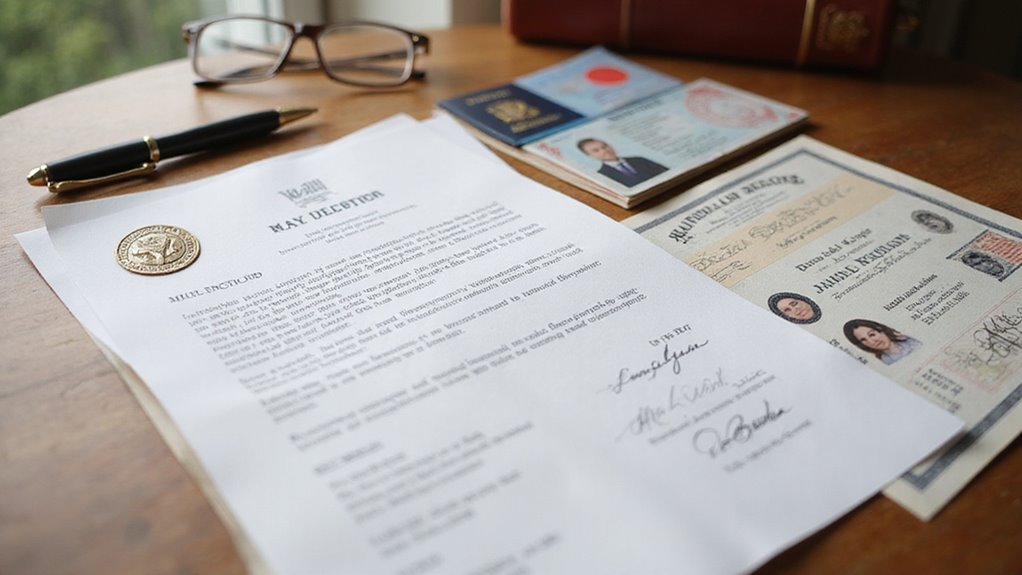Drowning in paperwork while grieving a loved one creates an overwhelming burden for new property heirs. The maze of legal requirements adds stress during an already difficult time, potentially delaying your ability to sell. Gathering the right documents early can transform this challenging process into a manageable task.
Selling inherited property requires several critical documents: death certificate, Letters of Testamentary or Administration from probate court, and the property deed. You’ll also need the will, affidavit of heirship, proof of inheritance, relevant tax documents, and consent forms from all heirs.
In this blog I will explore everything related to selling inherited property and the documents required for a smooth transaction.
Key Takeaways
- Official death certificate confirming the owner’s passing and legal ownership transfer.
- Probate documents such as Letters of Testamentary or Administration granting authority to sell.
- Valid property deed or title demonstrating current ownership rights.
- Inheritance-related documents like wills, affidavits of heirship, and tax records.
- Written consent from all heirs and property distribution agreements if multiple heirs are involved.
What Documents Do You Need to Sell an Inherited Property?

To sell an inherited property, you need several key documents. The death certificate of the deceased owner is required as legal proof of death.
You must obtain probate documents that establish your legal right to the property. These include Letters of Testamentary or Letters of Administration. The property deed or title is essential to confirm ownership details.
Additionally, you should gather any will documentation and tax records. These papers verify inheritance claims and tax obligations. Most counties also require affidavits of heirship in certain situations.
Before proceeding with any sale, ensure all documents are properly certified. This preparation prevents delays and legal complications during the selling process.
What Legal Documents Prove Your Inheritance Rights?

To prove your inheritance rights, you need specific legal documents. These include a death certificate, a valid will or testament, and letters of testamentary or administration.
In some cases, an affidavit of heirship can establish ownership without probate.
Death Certificate Requirements
Oklahoma requires an official death certificate to sell inherited property. This document proves the property owner’s passing and establishes inheritance rights. Death certificates must be obtained from the Oklahoma State Department of Health.
The certificate works alongside other legal documents like wills or affidavits of heirship. Together, these papers confirm your legal ownership of the inherited property.
As a result, securing this document promptly will streamline the property transfer process. Most importantly, without a valid death certificate, you can’t complete the inheritance transaction in Oklahoma.
Will or Testament Documentation
Legal documents prove your inheritance rights. A will or testament states the deceased’s wishes for asset distribution. Letters of testamentary give executors legal authority to manage the estate. An affidavit of heirship establishes inheritance without probate court.
U.S. inheritance laws require specific documentation based on your relationship to the deceased. Most states mandate original signed copies of wills for probate proceedings. Without these documents, claiming inheritance becomes significantly more difficult.
The probate court typically issues official documentation after validating the will. This process protects both heirs and creditors. Additionally, some financial institutions may require certified copies before releasing assets.
Letters of Testamentary or Administration
Letters of testamentary or administration prove your legal authority to manage an inherited estate. These court documents officially establish you as the estate administrator. They allow you to handle assets, sell property, and settle debts. Oklahoma law requires these documents for most estate transactions.
The probate court issues these letters after verifying your eligibility. You’ll need to submit the death certificate and will (if one exists). These documents help financial institutions recognize your authority to act on behalf of the estate.
Furthermore, they clarify tax obligations and prevent unauthorized access to estate assets. Request them early in the probate process to avoid delays.
Affidavit of Heirship
An Affidavit of Heirship proves your inheritance rights without probate court. This document shows you’re a legal heir when no testamentary letters exist.
You must include your relationship to the deceased, their death details, and your contact information. The document requires notarization to be legally valid.
Additional supporting affidavits strengthen your claim. Furthermore, witnesses familiar with the family history help verify your statements.
This simple document helps you establish ownership quickly. With proper documentation, you can access assets, sell property, and handle affairs efficiently.
How to Obtain Probate Documents?

To get probate documents, you need to start by filing a petition with the Oklahoma County District Court.
The court will verify your submitted documents and then issue the necessary letters of testamentary or administration. Keep in mind, the probate process usually takes several months to complete.
Filing Petition with Probate Court
You must file a petition with the probate court to begin the inheritance process in Oklahoma. This legal step establishes your authority to manage the estate.
The court requires several documents including the will or affidavit of heirship and death certificate. You’ll also need to request a letter of testamentary and complete all probate documentation.
Court fees apply when submitting these materials. The petition officially launches the probate process.
Once approved, you can legally handle the deceased’s property and assets. Furthermore, proper filing prevents potential legal complications later.
Document Verification Process
The probate court verifies your submitted documents to confirm inheritance rights. They examine your property ownership certificate, testamentary letters, and heirship affidavit.
All documents must be valid and properly issued before court authorization can proceed. This verification protects against fraud and ensures legal compliance.
The court staff compares signatures against official records and validates all seals. Additionally, they check for any missing pages or incomplete information.
Furthermore, this thorough review process typically takes 2-3 weeks depending on court caseloads.
Receiving Court Authorization
You need court approval before selling inherited property. The court will issue letters of testamentary or administration after verifying your documents. These papers legally confirm your authority to sell.
If probate isn’t required, an affidavit of heirship may suffice instead. The authorization process varies by jurisdiction. Courts typically review all submitted paperwork to verify your rightful claim.
Furthermore, understanding these steps prevents delays during the property sale. Make sure to keep copies of all authorization documents. These will be essential when working with title companies and potential buyers.
Timeframe for Probate Completion
Probate in Oklahoma typically takes 6-12 months to complete. The court needs this time to review your will and issue testamentary letters or administration documents.
Oklahoma law requires verification of the estate’s validity before granting legal authority to executors. This process happens in stages, with initial filing followed by court review.
During this period, you can’t legally sell inherited property until receiving official documentation.
Most simple estates finish closer to the 4-month timeframe. Complex estates with multiple assets or beneficiary disputes often require the full 6 months or longer.
What Property Documents Are Essential for the Sale?
Five key documents are necessary when selling an inherited property. The property deed proves your ownership rights to the land and building.
A title report confirms clear ownership without liens or disputes. You’ll also need estate inventory documentation that lists the property among the deceased’s assets.
Probate court documents show legal transfer of ownership after death. Finally, Letters of Testamentary or Administration establish your legal authority to sell.
These documents help potential buyers verify ownership legitimacy. With proper paperwork, you can avoid costly delays and legal complications.
What Tax Documents Should You Prepare?
You need several tax documents when selling an inherited property. Collect any inheritance tax forms, though Oklahoma has no state inheritance tax. Gather the property’s original purchase documents and proof of improvements.
You should also prepare the estate tax return if the estate exceeds exemption thresholds. Additionally, capital gains tax documentation is essential.
You’ll need to calculate the difference between the sale price and the stepped-up basis. This helps determine any taxable profit. Keep receipts for selling expenses too. These might reduce your overall tax liability.
How to Handle Multiple Heir Situations?
When handling multiple heirs, you need their written consent to sell the property and clear agreements on how to split proceeds.
Drafting property distribution agreements or buyout arrangements can prevent disputes.
If conflicts arise, resolving them through legal channels or mediation is essential to move forward efficiently.
Obtaining Consent Documentation
All heirs must provide written consent for property sales. You need proper documentation to legally proceed with any transaction. Collect an affidavit of heirship, signed property agreements, and formal consent forms from each heir.
Identify all beneficiaries through legal channels before initiating any paperwork. This verification prevents future disputes. Additionally, keep records of any buyout arrangements between heirs.
Throughout this process, maintain transparent communication with everyone involved. Clear documentation protects all parties and ensures the sale follows legal requirements. Most importantly, these steps create a smooth transfer of property rights.
Creating Property Distribution Agreements
Property distribution agreements formalize how estate proceeds are divided among heirs. These legal documents clearly outline each heir’s percentage and distribution method. They work alongside testamentary letters and heirship affidavits to prevent disputes.
The law requires all heirs to provide written consent before property sale proceeds can be distributed. After consent is obtained, create a formal agreement showing exact percentages. For example, one heir might receive 50%, another 30%, and a third 20%.
Distribution methods can vary based on heir preferences. Some heirs prefer direct bank transfers while others may choose buyout options from co-heirs.
Managing Buyout Arrangements
Buyout arrangements help resolve property ownership when multiple heirs want the same inherited property. Start by drafting clear distribution agreements that outline everyone’s rights.
Gather all inheritance documentation and review estate financial statements carefully. Set fair buyout terms that consider market value and existing liens.
Always secure written consent from every heir before finalizing any agreement. These measures prevent future disputes and ensure fair treatment.
The documentation protects all parties from misunderstandings later. A transparent process builds trust among family members during a difficult time.
Resolving Disputes Legally
Legal action provides the most secure path for settling inheritance disagreements. Draft clear property distribution documents first. Ask all heirs to sign these agreements promptly. Obtain affidavits of heirship when probate proceedings aren’t necessary.
For additional authority, request letters of testamentary from the court. This approach prevents future conflicts effectively. The court documents establish clear ownership rights.
Property transfers then proceed without complications. Most states require formal documentation to legally transfer disputed inherited property.
What Additional Documents Might Lenders Require?
Lenders typically require five main documents beyond standard paperwork. Proof of inheritance verifies your legal right to sell inherited property. A property valuation report establishes current market value. Title reports confirm clear ownership without liens.
You’ll also need a certified property deed showing legal ownership. Professional appraisals provide independent value assessments for financing approval.
Furthermore, these documents protect both you and the lender. Clear documentation speeds up the approval process and prevents delays.
Most importantly, having these papers ready demonstrates your seriousness as a seller.
Need to Sell an Inherited Property Fast? Contact Shawn Buys Houses Today
Shawn Buys Houses can help you sell inherited property quickly. They handle all paperwork including transfer forms and inheritance documentation.
Their team guides you through affidavits of heirship without delays. The process becomes straightforward with their professional assistance. You won’t need to navigate complex legal requirements alone. Property inheritance often involves specific documentation requirements under state law.
Furthermore, their service allows you to move forward without the usual selling hassles. This approach saves time and reduces stress during an already difficult period. Many clients appreciate their respectful handling of inherited properties.
Frequently Asked Questions
Do I Need a Lawyer to Sell Inherited Property in Oklahoma?
You don’t have to hire a lawyer to sell inherited property in Oklahoma, but consulting one can simplify probate, clarify legal rights, and ensure compliance, especially if multiple heirs, disputes, or complex legal issues arise during the sale process.
How Long Does the Probate Process Typically Take in Oklahoma?
While probate in Oklahoma usually takes several months, delays happen due to court backlogs or incomplete documents. You can help others by ensuring all paperwork is accurate and submitted promptly, speeding up the process and easing their burden.
Can I Sell Inherited Property Without Going Through Probate?
Yes, you can sell inherited property without probate if you have an affidavit of heirship or proper legal documents confirming ownership. Ensure all heirs agree, and consult legal experts to ensure a smooth, lawful transaction.
Are There Any Specific Tax Forms Required for Inherited Property Sale?
When selling inherited property, you typically need to file IRS Form 8949 and Schedule D for capital gains, and possibly other federal tax forms. Consult a tax professional to ensure you meet all federal reporting requirements efficiently.
What Happens if Multiple Heirs Can’t Agree on the Sale?
If heirs can’t agree on the sale, you should seek legal help or court intervention. Mediation or court orders can resolve disputes, ensure fair distribution, and assist the sale, protecting everyone’s rights and interests efficiently.


